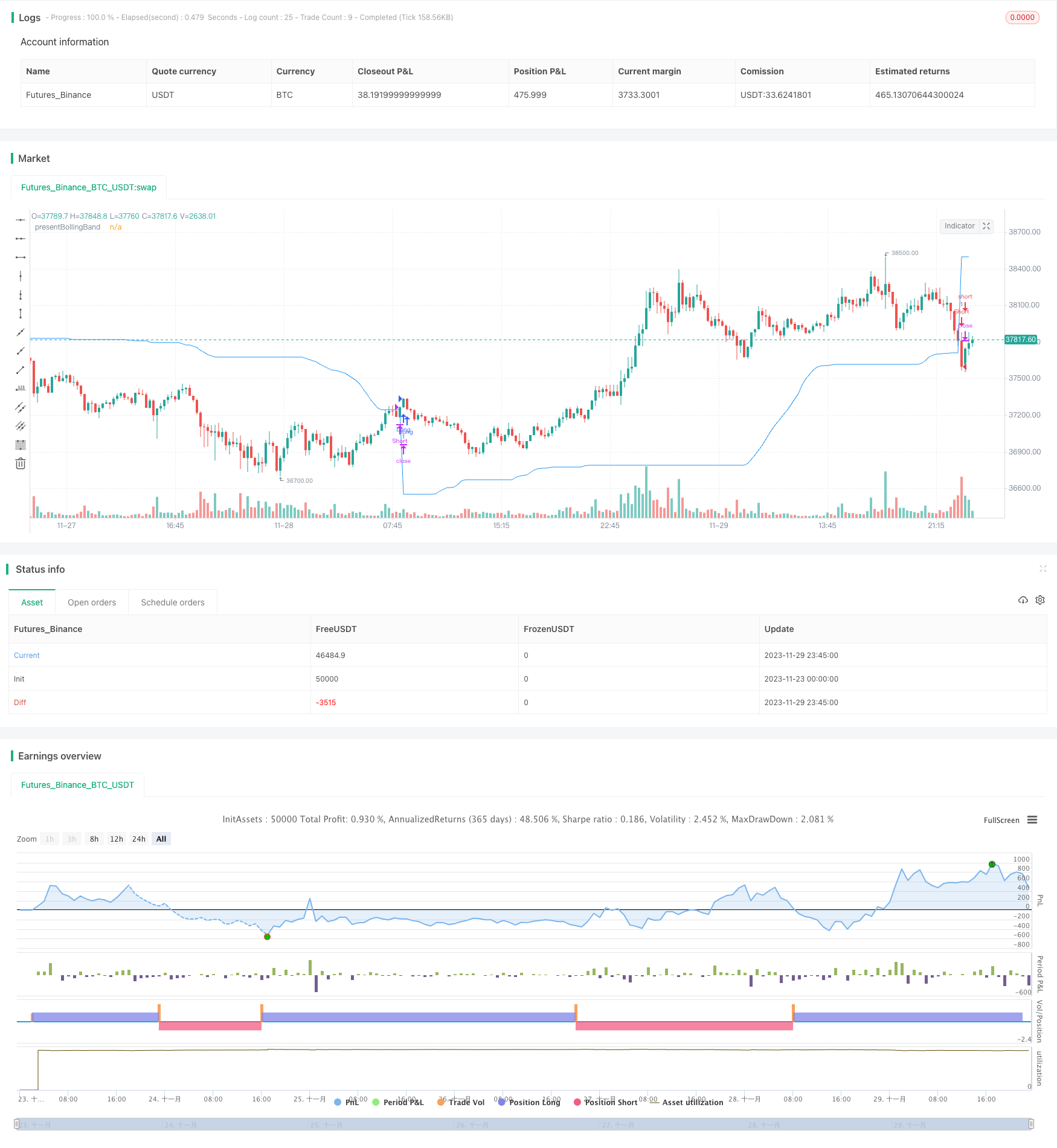Strategi penangkapan volatilitas dinamis RSI-Bollinger Bands

Ringkasan
RSI-Bulling Band Strategi adalah strategi perdagangan yang mengintegrasikan konsep Bulling Band (BB), Relatif Lemah Indikator (RSI) dan Sederhana Moving Average (SMA). Strategi ini unik karena menghitung tingkat dinamis antara harga close out di atas dan di bawah rel. Fitur unik ini memungkinkan strategi ini untuk beradaptasi dengan volatilitas pasar dan perubahan harga.
Pasar cryptocurrency dan saham sangat berfluktuasi, sehingga sangat cocok untuk menggunakan strategi Brinks. RSI dapat membantu mengidentifikasi overbought dan oversold di pasar yang sering spekulatif ini.
Prinsip Strategi
Bolling Band Dinamis: Strategi ini pertama-tama menghitung Bolling Band atas dan bawah berdasarkan panjang dan kelipatan yang didefinisikan pengguna. Kemudian menyesuaikan nilai Bolling Band saat ini dengan kombinasi Bolling Band dan harga penutupan yang dinamis.
RSI: Jika pengguna memilih untuk menggunakan RSI untuk menghasilkan sinyal, strategi ini juga menghitung RSI dan SMA, dan menggunakannya untuk menghasilkan sinyal over dan under tambahan.
Strategi ini kemudian memeriksa arah perdagangan yang dipilih, dan masuk ke posisi jual atau jual. Jika arah perdagangan ditetapkan sebagai pivoted, strategi ini dapat masuk ke posisi jual dan jual secara bersamaan.
Akhirnya, jika harga tutup melewati present BollingBand, maka posisi tersebut akan ditutup. Jika harga tutup melewati present BollingBand, maka posisi tersebut akan ditutup.
Analisis Keunggulan
Strategi ini menggabungkan keunggulan dari Brinks, RSI dan SMA, mampu beradaptasi dengan volatilitas pasar, secara dinamis menangkap fluktuasi, menghasilkan sinyal perdagangan dalam kasus overbought dan oversold.
Indikator RSI melengkapi sinyal perdagangan Brin Belt untuk menghindari kesalahan masuk di pasar yang bergoyang. Ini memungkinkan pilihan untuk melakukan perdagangan hanya lebih, hanya lebih atau dua arah, sesuai dengan kondisi pasar yang berbeda.
Parameter dapat disesuaikan dengan preferensi risiko pribadi.
Analisis risiko
Strategi ini bergantung pada indikator-indikator teknis dan tidak mampu menghadapi pergeseran besar yang disebabkan oleh fundamental.
Setting parameter Brinband yang tidak tepat dapat menyebabkan sinyal perdagangan yang terlalu sering atau terlalu jarang.
Perdagangan dua arah meningkatkan risiko, dan perlu waspada terhadap kerugian akibat melakukan shorting.
Disarankan untuk mengontrol risiko dengan menggunakan stop loss.
Arah optimasi
Kombinasi dengan indikator lain untuk memfilter sinyal, seperti MACD.
Meningkatkan strategi stop loss.
Optimalkan parameter BRI dan RSI.
Parameter disesuaikan dengan jenis dan siklus transaksi yang berbeda.
Pertimbangkan untuk mengoptimalkan hard disk, menyesuaikan parameter untuk menyesuaikan dengan situasi yang sebenarnya.
Meringkaskan
Strategi ini merupakan strategi yang didorong oleh indikator-indikator teknis, yang menggabungkan keunggulan dari indikator Brin, RSI, dan SMA, untuk menangkap pergerakan pasar melalui penyesuaian dinamis Brin. Strategi ini dapat disesuaikan dan dioptimalkan dengan ruang yang luas, tetapi tidak dapat memprediksi perubahan fundamental.
/*backtest
start: 2023-11-23 00:00:00
end: 2023-11-30 00:00:00
period: 15m
basePeriod: 5m
exchanges: [{"eid":"Futures_Binance","currency":"BTC_USDT"}]
*/
// This source code is subject to the terms of the Mozilla Public License 2.0 at https://mozilla.org/MPL/2.0/
// © PresentTrading
//@version=5
// Define the strategy settings
strategy('Volatility Capture RSI-Bollinger - Strategy [presentTrading]', overlay=true)
// Define the input parameters for the indicator
priceSource = input.source(title='Source', defval=hlc3, group='presentBollingBand') // The price source to use
lengthParam = input.int(50, 'lengthParam', minval=1, group='presentBollingBand') // The length of the moving average
multiplier = input.float(2.7183, 'Multiplier', minval=0.1, step=.1, group='presentBollingBand') // The multiplier for the ATR
useRSI = input.bool(true, 'Use RSI for signals', group='presentBollingBand') // Boolean input to decide whether to use RSI for signals
rsiPeriod = input.int(10, 'RSI Period', minval=1, group='presentBollingBand') // The period for the RSI calculation
smaPeriod = input.int(5, 'SMA Period', minval=1, group='presentBollingBand') // The period for the SMA calculation
boughtRange = input.float(55, 'Bought Range Level', minval=1, group='presentBollingBand') // The level for the bought range
soldRange = input.float(50, 'Sold Range Level', minval=1, group='presentBollingBand') // The level for the sold range
// Add a parameter for choosing Long or Short
tradeDirection = input.string("Both", "Trade Direction", options=["Long", "Short", "Both"], group='presentBollingBand') // Dropdown input for trade direction
// Calculate the bollingerBand
barIndex = bar_index // The current bar index
upperBollingerBand = ta.sma(high, lengthParam) + ta.stdev(high, lengthParam) * multiplier // Calculate the upper Bollinger Band
lowerBollingerBand = ta.sma(low, lengthParam) - ta.stdev(low, lengthParam) * multiplier // Calculate the lower Bollinger Band
var float presentBollingBand = na // Initialize the presentBollingBand variable
crossCount = 0 // Initialize the crossCount variable
// Calculate the buy and sell signals
longSignal1 = ta.crossover(priceSource, presentBollingBand) // Calculate the long signal
shortSignal1 = ta.crossunder(priceSource, presentBollingBand) // Calculate the short signal
// Calculate the RSI
rsiValue = ta.rsi(priceSource, rsiPeriod) // Calculate the RSI value
rsiSmaValue = ta.sma(rsiValue, smaPeriod) // Calculate the SMA of the RSI value
// Calculate the buy and sell signals
longSignal2 = rsiSmaValue > boughtRange // Calculate the long signal based on the RSI SMA
shortSignal2 = rsiSmaValue < soldRange // Calculate the short signal based on the RSI SMA
presentBollingBand := na(lowerBollingerBand) or na(upperBollingerBand)?0.0 : close>presentBollingBand?math.max(presentBollingBand,lowerBollingerBand) : close<presentBollingBand?math.min(presentBollingBand,upperBollingerBand) : 0.0
if (tradeDirection == "Long" or tradeDirection == "Both") and longSignal1 and (useRSI ? longSignal2 : true) // Use RSI for signals if useRSI is true
presentBollingBand := lowerBollingerBand // If the trade direction is "Long" or "Both", and the long signal is true, and either useRSI is false or the long signal based on RSI is true, then assign the lowerBollingerBand to the presentBollingBand.
strategy.entry("Long", strategy.long) // Enter a long position.
if (tradeDirection == "Short" or tradeDirection == "Both") and shortSignal1 and (useRSI ? shortSignal2 : true) // Use RSI for signals if useRSI is true
presentBollingBand := upperBollingerBand // If the trade direction is "Short" or "Both", and the short signal is true, and either useRSI is false or the short signal based on RSI is true, then assign the upperBollingerBand to the presentBollingBand.
strategy.entry("Short", strategy.short) // Enter a short position.
// Exit condition
if (strategy.position_size > 0 and ta.crossunder(close, presentBollingBand)) // If the strategy has a long position and the close price crosses under the presentBollingBand, then close the long position.
strategy.close("Long")
if (strategy.position_size < 0 and ta.crossover(close, presentBollingBand)) // If the strategy has a short position and the close price crosses over the presentBollingBand, then close the short position.
strategy.close("Short")
//~~ Plot
plot(presentBollingBand,"presentBollingBand", color=color.blue) // Plot the presentBollingBand on the chart.